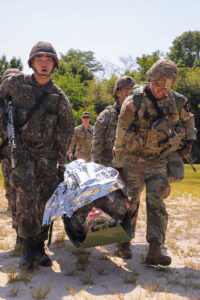
Story by Sgt. Liseth Espinel
2nd Infantry Division/ROK-U.S. Combined Division
CAMP HUMPHREYS, South Korea – Medics from the 2nd Infantry Division/ROK-U.S. Combined Division and Korean Armed Forces Medical School students conducted a Combined Comprehensive Medical Training in Daejeon, South Korea, May 29, 2024.
Comprehensive medical training is a behavioral education conducted for officers and non-commissioned officers in medical school. It is an integrated and final task that requires the trainees to directly apply what they have learned from the initial situation reception to patient care. This is based on tactics, patient evacuation, basic trauma treatment, and other subjects.
For the first time, the U.S. military participated in comprehensive medical training since the medical school established and implemented an ‘education system optimization model centered in behavioral training task.’
“Through ROK-U.S. joint team training, we strengthened the friendship between the two countries and reached a consensus on the importance of joint medical support training focused on field treatment,” said Sgt. Maj. Kiriagos Bauer, Chief of the Medical Staff of the 2ID/RUCD.
The training aims to improve the Soldier’s operational capabilities by having them participate in various activities, from mastering basic procedures to discussing medical tactics, general behavioral training, and night training.
During the three-day training, the U.S. Army and the Republic of Korea’s army mastered patient evacuation procedures, patient treatment according to type and situation, and chemical, biological, and radiological medical support.
During the night training, they complete the CBRN medical support, which includes classifying contaminated war casualties, operating a detoxification station, and evacuating patients under limited visibility, such as putting on a gas mask in the dark while operating a treatment team for mass war casualties brought by a chemical war.
“I hope that this ROK-U.S. combined medical training will improve the medical support capabilities of both countries and provide an opportunity for an immediate joint response in case of emergency,” said Lt. Col. Do-hak Lee, head of the Medical Tactics Department of the 2ID/RUCD.
When treating the patients, the two forces worked together to become each other’s hands and feet. Through teamwork, they overcame limitations such as communication that may arise while providing medical support.